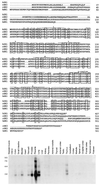A human intermediate conductance calcium-activated potassium channel
- PMID: 9326665
- PMCID: PMC23567
- DOI: 10.1073/pnas.94.21.11651
A human intermediate conductance calcium-activated potassium channel
Abstract
An intermediate conductance calcium-activated potassium channel, hIK1, was cloned from human pancreas. The predicted amino acid sequence is related to, but distinct from, the small conductance calcium-activated potassium channel subfamily, which is approximately 50% conserved. hIK1 mRNA was detected in peripheral tissues but not in brain. Expression of hIK1 in Xenopus oocytes gave rise to inwardly rectifying potassium currents, which were activated by submicromolar concentrations of intracellular calcium (K0.5 = 0.3 microM). Although the K0.5 for calcium was similar to that of small conductance calcium-activated potassium channels, the slope factor derived from the Hill equation was significantly reduced (1.7 vs. 3. 5). Single-channel current amplitudes reflected the macroscopic inward rectification and revealed a conductance level of 39 pS in the inward direction. hIK1 currents were reversibly blocked by charybdotoxin (Ki = 2.5 nM) and clotrimazole (Ki = 24.8 nM) but were minimally affected by apamin (100 nM), iberiotoxin (50 nM), or ketoconazole (10 microM). These biophysical and pharmacological properties are consistent with native intermediate conductance calcium-activated potassium channels, including the erythrocyte Gardos channel.
Figures




References
-
- Latorre R, Oberhauser A, Labarca P, Alvarez O. Annu Rev Phys. 1989;51:385–399. - PubMed
-
- Atkinson N S, Robertson G A, Ganetzky B. Science. 1991;253:551–555. - PubMed
-
- Adelman J P, Shen K Z, Kavanaugh M P, Warren R A, Wu Y N, Lagrutta A, Bond C T, North R A. Neuron. 1992;9:209–216. - PubMed
-
- Butler A, Tsunoda S, McCobb D P, Wei A, Salkoff L. Science. 1993;261:221–224. - PubMed
-
- Köhler M, Hirschberg B, Bond C T, Kinzie J M, Marrion N V, Maylie J, Adelman J P. Science. 1996;273:1709–1714. - PubMed
Publication types
MeSH terms
Substances
Associated data
- Actions
LinkOut - more resources
Full Text Sources
Other Literature Sources
Molecular Biology Databases

